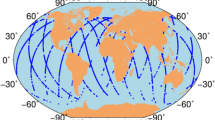Abstract
Global ionosphere maps (GIMs) provided by the global navigation satellite systems (GNSS) data are essential in ionospheric research as the source of the global vertical total electron content (VTEC). However, conventional GIMs experience lower accuracy and reliability from uneven distribution of GNSS tracking stations, especially in ocean areas with few tracking stations. The orbits of ocean altimetry satellite cover vast ocean areas and can directly provide VTEC at nadir with two different wavelengths of radio waves. Radio occultation observations and the beacons of Doppler orbitography and radio positioning integrated by satellite (DORIS) are evenly distributed globally. Satellite altimetry, radio occultation and DORIS can compensate GNSS data in ocean areas, allowing a more accurate and reliable GIMs to be formed with the integration of these observations. This study builds GIMs with temporal intervals of 2 h by the integration of GNSS, satellite altimetry, radio occultation and DORIS data. We investigate the integration method for multi-source data and used the data in May 2013 to validate the effectiveness of integration. Result shows that VTEC changes by −11.0 to −7.0 TECU after the integration of satellite altimetry, radio occultation and DORIS data. The maximum root mean square decreases by 5.5 TECU, and the accuracy of GIMs in ocean areas improves significantly.















Similar content being viewed by others
References
Alizadeh M, Schuh H, Todorova S, Schmidt M (2011) Global ionosphere maps of VTEC from GNSS, satellite altimetry, and Formosat-3/COSMIC data. J Geodesy 85(12):975–987
Auriol A, Tourain C (2010) DORIS system: the new age. Adv Space Res 46(12):1484–1496
Brunini C, Meza A, Bosch W (2005) Temporal and spatial variability of the bias between TOPEX- and GPS-derived total electron content. J Geod 79(4–5):175–188
Chen P, Chen J (2014) The multi-source data fusion global ionospheric modeling software—IonoGim. Adv Space Res 53(11):1610–1622
Chen P, Yao W, Zhu X (2015) Combination of ground-and space-based data to establish a global ionospheric grid model. IEEE Trans Geosci Remote Sens 53(2):1073–1081
Dettmering D, Schmidt M, Heinkelmann R, Seitz M (2011) Combination of different space-geodetic observations for regional ionosphere modeling. J Geod 85(12):989–998
Feltens J (2003) The international GPS service (IGS) Ionosphere working group. Adv Space Res 31(3):635–644
Fong C-J, Yen NL, Chu C-H, Yang S-K, Shiau W-T, Huang C-Y, Chi S, Chen S-S, LiouY-A KuoY-H (2009) FORMOSAT-3/COSMIC spacecraft constellation system, mission results, and prospect for follow-on mission. Terr Atmos Ocean Sci 20:1–19
Hernández-Pajares M, Juan JM, Sanz J, Orus R, Garcia-Rigo A, Feltens J, Krankowski A (2009) The IGS VTEC maps: a reliable source of ionospheric information since 1998. J Geodesy 83(3–4):263–275
Koch KR, Kusche J (2002) Regularization of geopotential determination from satellite data by variance components. J Geodesy 76(5):259–268
Li Z, Yuan Y, Li H, Ou J, Huo X (2012) Two-step method for the determination of the differential code biases of COMPASS satellites. J Geodesy 86(11):1059–1076
Mannucci AJ, Wilson BD, Yuan DN, Ho CH, Lindqwister UJ, Runge TF (1998) A global mapping technique for GPS-derived ionospheric total electron content measurements. Radio Sci 33(3):565–582
Mercier F, Cerri L, Berthias JP (2010) Jason-2 DORIS phase measurement processing. Adv Space Res 45(12):1441–1454
Schaer S (1999) Mapping and predicting the earth’s ionosphere using the Global Positioning System. Ph.D. thesis, Bern University, Switzerland
Todorova S, Schuh H, Hobiger T (2007) Using the global navigation satellite systems and satellite altimetry for combined global ionosphere maps. Adv Space Res 42:727–736
Yuan YB (2002) Theory and method research of GPS-based ionospheric monitoring and delay correction. Institute of Geodesy and Geophysics, CAS, Wuhan
Zhang X, Tang L (2014) Daily global plasmaspheric maps derived from cosmic GPS observations. IEEE Trans Geosci Remote Sens 52(10):6040–6046
Acknowledgments
We thank CDDIS for providing GNSS and DORIS observation data, CNES and NOAA for providing Jason-1 and Jason-2 GDR data, respectively, NOAA for providing ionosonde data and CDAAC for providing COSMIC “ionprf” data. This study was funded by the National Natural Science Foundation of China (41404031) and Key Laboratory of Geo-informatics of State Bureau of Surveying and Mapping (201420).
Author information
Authors and Affiliations
Corresponding author
Rights and permissions
About this article
Cite this article
Chen, P., Yao, Y. & Yao, W. Global ionosphere maps based on GNSS, satellite altimetry, radio occultation and DORIS. GPS Solut 21, 639–650 (2017). https://doi.org/10.1007/s10291-016-0554-9
Received:
Accepted:
Published:
Issue Date:
DOI: https://doi.org/10.1007/s10291-016-0554-9




